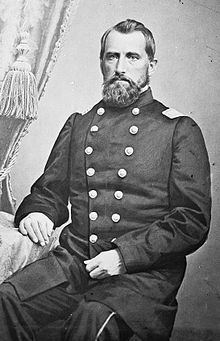James M. Tuttle
| James Madison Tuttle | |
|---|---|

Gen. James M. Tuttle
|
|
| Born |
September 24, 1823 Summerfield, Ohio |
| Died | October 24, 1892 (aged 69) Des Moines, Iowa |
| Place of burial | Woodland Cemetery, Des Moines, Iowa |
| Allegiance |
United States of America Union |
| Service/branch |
United States Army Union Army |
| Years of service | 1861–1864 |
| Rank |
|
| Unit | Army of the Tennessee |
| Commands held | 3rd Division, XV Corps 1st Division, XVI Corps |
| Battles/wars | |
| Other work | businessman, Iowa state representative |
James Madison Tuttle (September 24, 1823 – October 24, 1892) was a soldier, businessman, and politician from the state of Iowa who served as a general in the Union Army during the American Civil War. He commanded a brigade and then a division in the Army of the Tennessee in several campaigns in the Western Theater of operations. He led the first Union troops that entered the enemy-held Fort Donelson in 1862, paving the way for the fort's subsequent surrender to Ulysses S. Grant and opening the Cumberland River as an avenue of invasion of the South.
James M. Tuttle was born near Summerfield, Ohio, in rural Noble County (then Monroe County) to James and Esther (Crow) Tuttle. When he was ten years old, Tuttle's family moved to Indiana, where his father, a Maine-born farmer who kept migrating westward, finally settled in Fayette County. Young Tuttle was educated in the common schools of Ohio and Indiana.
In the spring of 1846 the 23-year-old Tuttle moved to Farmington, Iowa, where he engaged both in agricultural and mercantile pursuits. He briefly returned to Fayette County, Indiana, in the fall of 1847, where he married Elizabeth Conner on September 22. They established a household in Farmington. However, Elizabeth Tuttle died on their fourth wedding anniversary. On August 17, 1853, Tuttle married Ohio-born Laura M. Meek in Farmington; they would have five children together.
Tuttle entered local politics as a Democrat, and was elected in 1855 as the sheriff of Van Buren County, serving two years. In the autumn of 1857, he was elected as the County Treasurer and Recorder, serving a pair of 2-year terms.
...
Wikipedia
